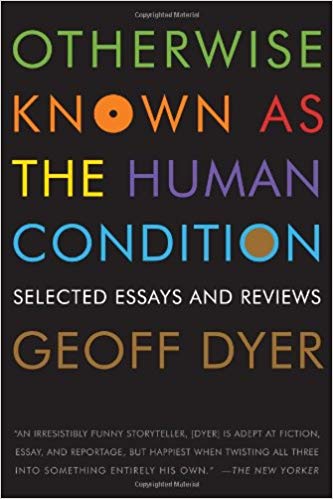
As someone who claims to blog thematically about “the power of words” but occasionally interrupts his wordiness with photographs, I find it heartening that Geoff Dyer should open his latest collection of writings, Otherwise Known as the Human Condition, with a section devoted to photographers and their work. Whatever his rationale, I want to adopt it. In his introduction, he notes “the unruly range of [his] concerns” and describes himself as a “gate-crasher” into disciplines (like jazz) about which he has much interest but little knowledge. He assumes the posture of Hazlitt—to “loiter—with no intent of entering—outside of the academy, unburdened by specialization … and the rigors of imposed method.” And so he offers his writings in five discrete sections: Visuals, Verbals, Musicals, Variables, and Personals. What ties these themes together, or what demands that they be tied together, is the fact that they all issue from a single personality. That fact provides the essays with an overarching narrative logic; the reader is on a voyage of discovery, the slow revelation of a person who occupies a unique space in the world.
In two of his essays, Dyer draws on Marc Augé’s Non-Places: Introduction to an Anthropology of Supermodernity. In the first, Dyer describes his brief stint as a Def Leppard groupie when the band played a concert in Seoul. He suggests that the members of Def Leppard are residents of the supermodern world, where one hotel looks the same as any other, as do the airports, restaurants, limousines, and concert venues. One might go so far as to say that Def Leppard plays supermodern music, the heavy metal equivalent of elevator muzak (can you hum any Def Leppard tunes off the top of your head?) And, as the punch line for this piece, it appears that people are also interchangeable. What goes unsaid is that the notion of supermodernity may also apply to writing, which has detached itself from a rootedness in place and wings its way around the globe through fiber optic cables and satellite transmissions.
Dyer continues in this supermodern vein with “Sex and Hotels”, an essay about the relationship between the generic luxury hotel and pornography. By their very non-placeness, luxury hotels are the ideal locale to view pornography, the ideal setting to film pornography, and they somehow elicit in their guests long-buried sexual proclivities. The Dominique Strauss-Kahn scandal is a case in point. Whatever the legality of his exchange with a chambermaid in a New York City hotel, it is clear that he was engaged in behaviour that he is unlikely to repeat with his wife in their matrimonial residence. Again, one can infer from Dyer that the supermodern non-placeness of internet writing evokes similar pornographic tendencies. The utter sameness of Huffpo articles elicits from readers a kind of cultural masturbatory response.
Anybody devoted to quality writing and original thought will feel inclined to resist the supermodern tendencies of internet writing. Which makes the intrusion of personality a relief. By “personality”, I don’t mean a gushing effusiveness or belligerent ranting, but something more subtle, a presence in the writing that hints at a distinctive world view mediated by unique experience. While Dyer is deliberately autobiographical in the “Personals” section (we learn whether or not he had sex on his first date with the woman who later became his wife), we detect hints of the autobiographical even in his more scholarly pieces (it is not without good reason that he bears a strong affinity for the novels of D. H. Lawrence).
Which returns me to the question I posed at the outset: how does a writer justify devoting more than a quarter of the words in his new book to a visual medium (and another significant chunk to music)? The short answer is that writing has to be about something. I grow tired of the solidly crafted work from writers freshly squeezed out of MFA programs. It’s like drinking air from an empty crystal goblet. For Dyer, writing is the occasion to share other commitments—commitments which may well be more important than the writing itself.
But there may be a more complicated answer. Photographers provide Dyer with another example of what appears to be a persistent concern: the supermodern erosion of discrete experience. His essay on Robert Capa is almost elegiac. There was in Capa’s work during WWII a thisness which a handful of other war correspondents approximated but which has disappeared since the advent of digital reportage with its clarity and gruesome explicitness. Now, war photographers take the same risks, but do so for the sake of a visual record which is indistinguishable from pornography. They’re in the field for the cum kill shot, since that’s what sells papers (and pays their salaries). A photo by Capa is a photo of Capa or at least sufficiently distinctive in the view it presents that we can’t help but note Capa’s presence in the work.
Geoff Dyer aspires to the same thing. But because he doesn’t own a camera, he captures his experience with words. A photograph or an essay, it doesn’t really matter. When done well, both draw us into the distinctiveness of the experience they present and buttress us against an onslaught of the supermodern.